
Today we’re conquering our fears and making homemade croissants! If you’re about to run away screaming, I understand. I’m not sugarcoating it: croissants aren’t easy. Croissants require time, patience, and a lot of rolling. However, just because this recipe is advanced doesn’t mean that YOU have to be an advanced baker to try it. You can absolutely handle this quintessential baking bucket list recipe. ♥
Let me hold your hand through the whole process. I’m sharing step-by-step photography, a full video tutorial, plenty of tricks based on what I’ve learned, and the croissant recipe. I started working on croissants earlier this year. I studied a couple recipes, tested them, tweaked what I found necessary, and played with this dough for weeks. The croissants are golden brown, extra flaky, crisp on the outside, soft on the inside, and unbelievable warm from the oven. One bite of this delicate French pastry will immediately transport you to a quaint French bakery. I’m confident in this homemade croissants recipe and I’m confident in YOU baking them.
The good news! You need zero fancy equipment and zero special ingredients. If you’re looking for a weekend project, know how to read directions, and crave a fresh homemade pastry (don’t we all?), then stick around. You’ll be rewarded with the BEST treat ever!!!
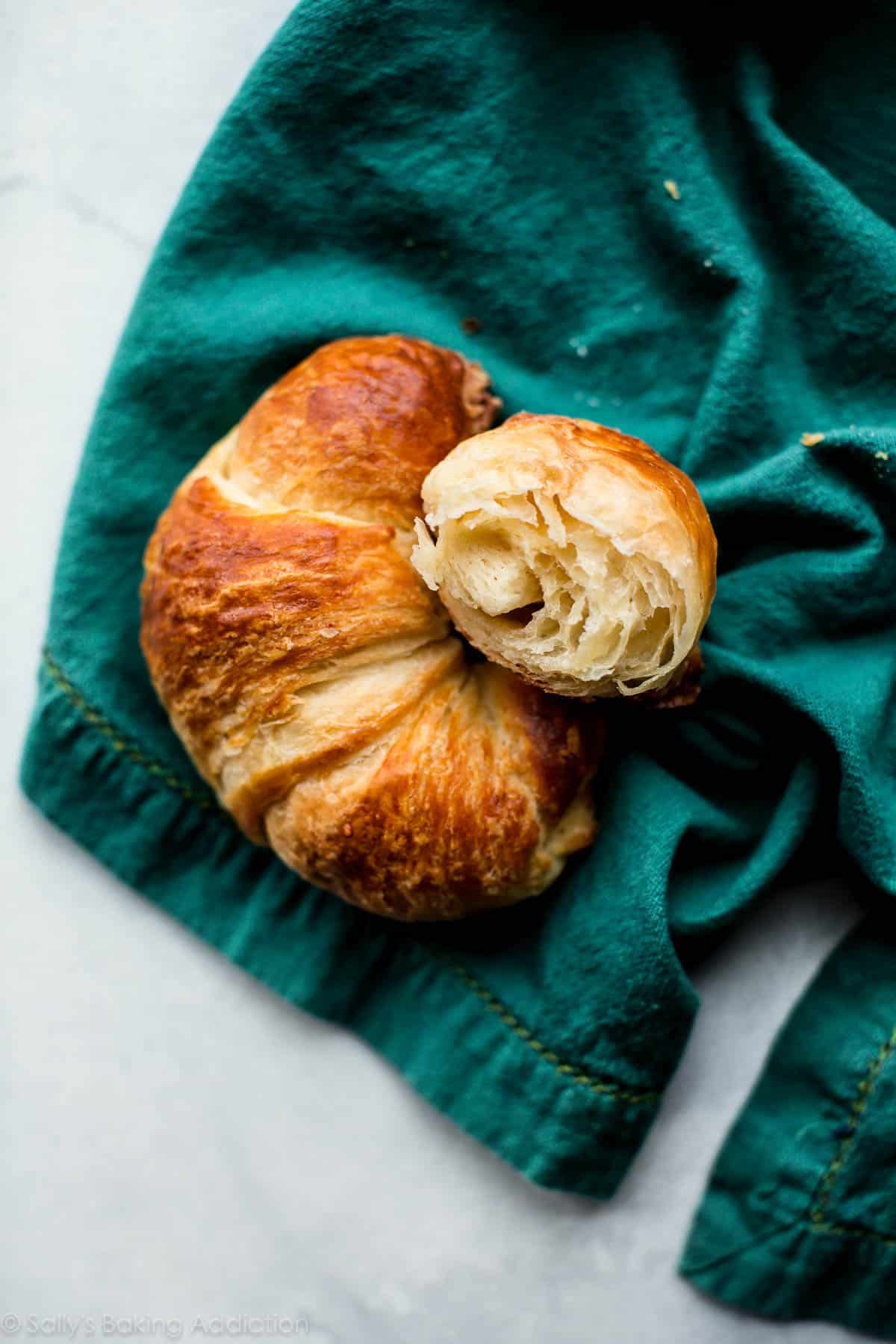
Let’s get right into it. Just like making mille-feuille, making croissants is a labor of love. The long recipe directions and all these step-by-step photographs seem intimidating, but let me walk you through the basic process so you aren’t nervous.
The Process
- make easy dough from butter, flour, sugar, salt, yeast, and milk
- roll out dough into a large rectangle
- make the butter layer (I have an easy trick for this!!!)
- enclose the butter layer inside the dough
- roll out the dough into another large rectangle, then fold it back together
- roll out the dough again, fold it back together again
- roll out the dough one more time, fold it back together
- shape the croissants
- bake
There’s resting time between most steps, which means most of the time is hands off. To help us develop all the layers, croissant dough needs to rest in the refrigerator often. That’s why I call making croissants a project. Do it over a couple days with long breaks between the steps.

All that rolling out and folding back together? That’s called LAMINATING.
What is Laminated Dough?
Laminating dough is the process of folding butter into dough many times, which creates multiple alternating layers of butter and dough. When the laminated dough bakes, the butter melts and creates steam. This steam lifts the layers apart, leaving us with dozens of flaky airy buttery layers.
Just like we do when we make a croissant bread loaf, We’re going to laminate the dough 3 times, which will create 81 layers in our croissants. Yes, 81! Let me paint that picture for you.
- Start with dough, butter layer, dough = 3 layers
- Roll it out and fold it into thirds = 9 layers
- Roll that out and fold it into thirds = 27 layers
- Roll that out one last time and fold it into thirds = 81 layers
So we’re only laminating the dough 3 times, but that gives us 81 layers. When the croissants are rolled up and shaped, that’s one 81 layer dough rolled up many times. So when you bite into a croissant, you’re literally biting into hundreds of layers.
Isn’t that SO COOL???

Croissants Video Tutorial
Watch me make croissants in this video. I talk you through the whole video too.
Now let’s see everything come together in step-by-step photographs.
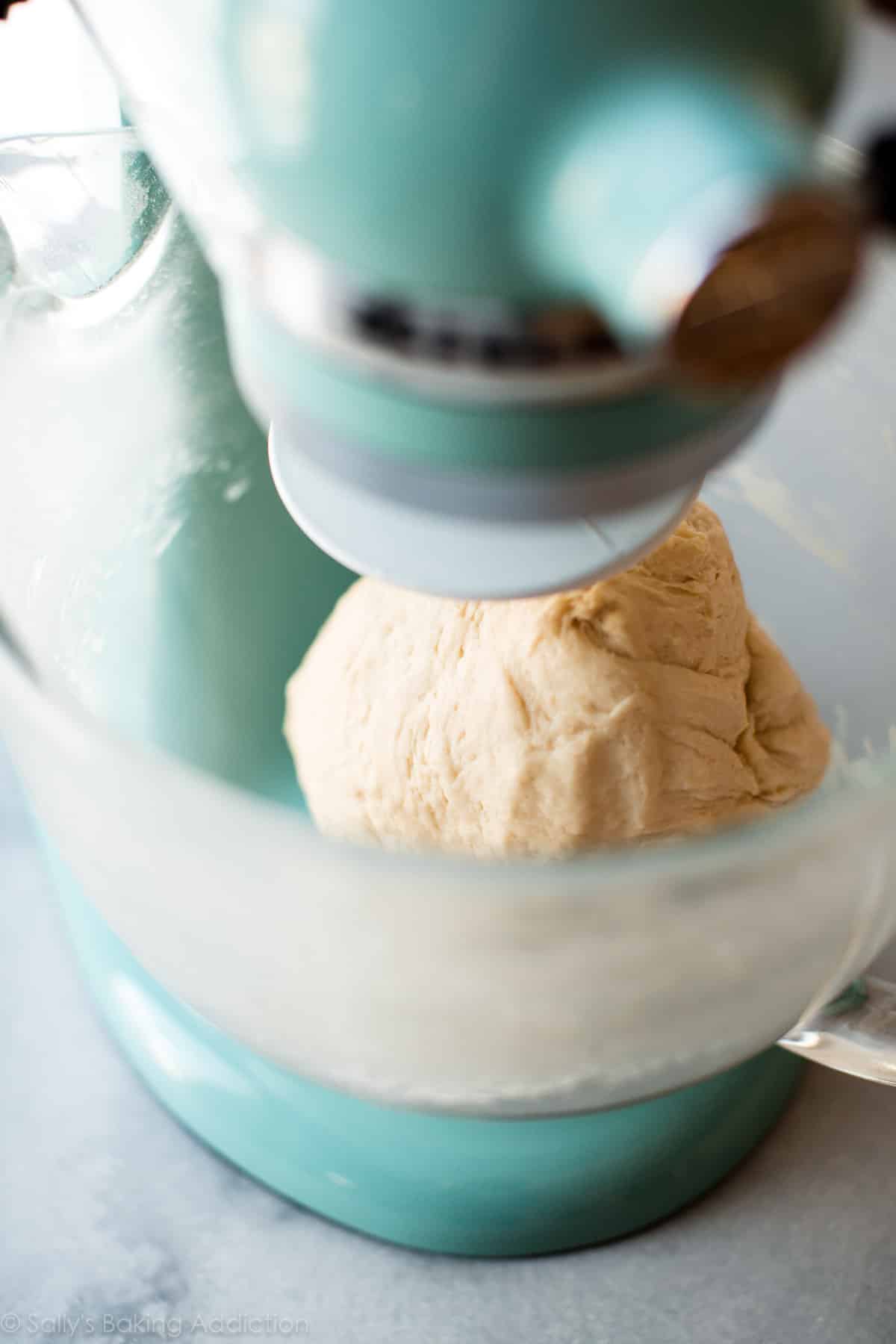
DOUGH
Croissant dough begins with butter, flour, sugar, salt, yeast, and milk. Unlike most yeasted doughs that require warm liquid to activate the yeast, you’re going to use cold milk. The yeast will work its magic later on in the recipe. In the beginning steps of croissants, the dough should always be cold. If, at any point, the dough becomes too warm… stop. Stop what you’re doing and place the dough back in the refrigerator for 20 minutes.
The mixer will beat the dough for about 5 minutes. Stand by your mixer as it works the dough. This dough isn’t particularly heavy, but your mixer will still get a workout. Did you see my Instagram story when my mixer FELL OFF MY COUNTER? I walked away at the wrong time and the whole thing danced off the counter. Unplugged itself and everything. Don’t make my mistake!
See my How to Knead Dough video tutorial if you need any extra help with the kneading step.
We made the dough, now we’re going to cover it and let it rest in the refrigerator for 30 minutes.
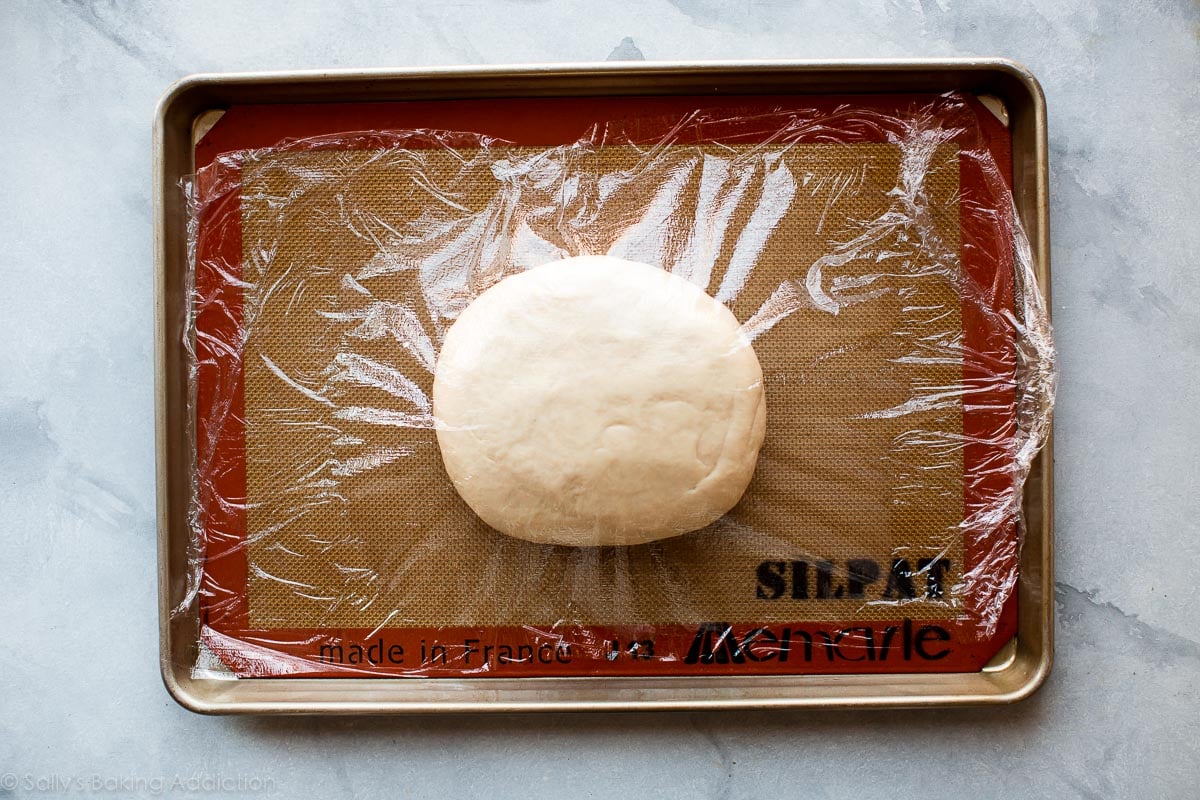
Now let’s roll out the dough into a 14×10-inch rectangle. Use a clean ruler or measuring tape. The ruler or measuring tape, besides your rolling pin, is the most crucial tool when making croissants.
I recommend using a silicone baking mat. While we will still lightly flour it, the mat is nonstick and it’s a handy guide for the exact measurement. You also need to transfer the dough to a baking sheet and the silicone baking mat makes that possible.
The dough isn’t extremely cold after only 30 minutes in the refrigerator, so it will be easy to roll out. Be precise with the 14×10-inch measurement. The dough will want to be oval shaped, but keep working the edges with your hands and rolling pin until you have the correct size rectangle. You can see how I do all this in the video below.
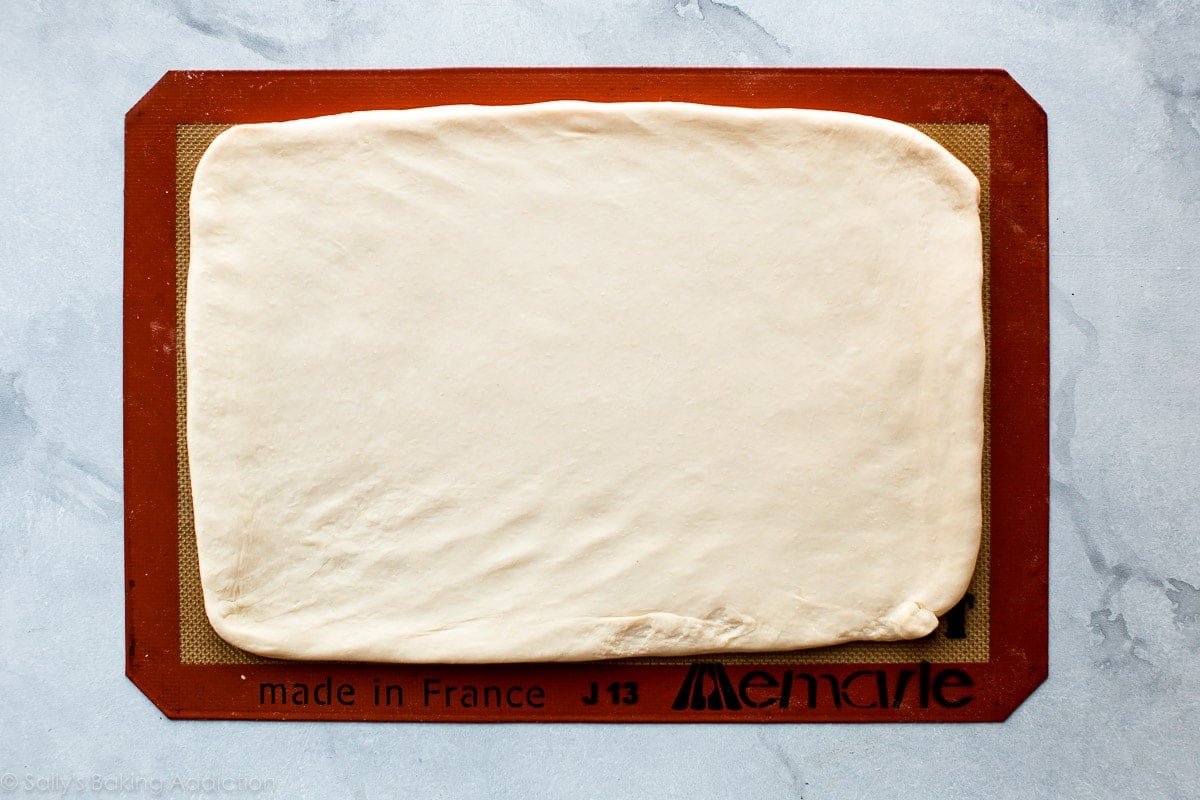
Cover the rolled out dough and chill it for 4 hours or overnight. Literally pick up the silicone baking mat, put it on top of your baking sheet, cover the dough, and chill it. I usually chill it for 4 hours because there is one more 4 hour or overnight chill period coming up. That’s when I typically chill it overnight, making this a 2 day recipe.
BUTTER
Many croissant recipes instruct you to shape extremely cold butter into a rectangle or square. Have you ever tried to manipulate cold sticks of butter into another shape? It’s really hard. I learned the following trick from Zoe at Zoe Bakes. Please go follow Zoe, she is the absolute best. ♥
Start with softened butter, beat it with flour so it has some stability, then spread into a rectangle and chill it. It’s 100x easier to shape softened butter than it is to shape cold butter. Thank you, Zoe!
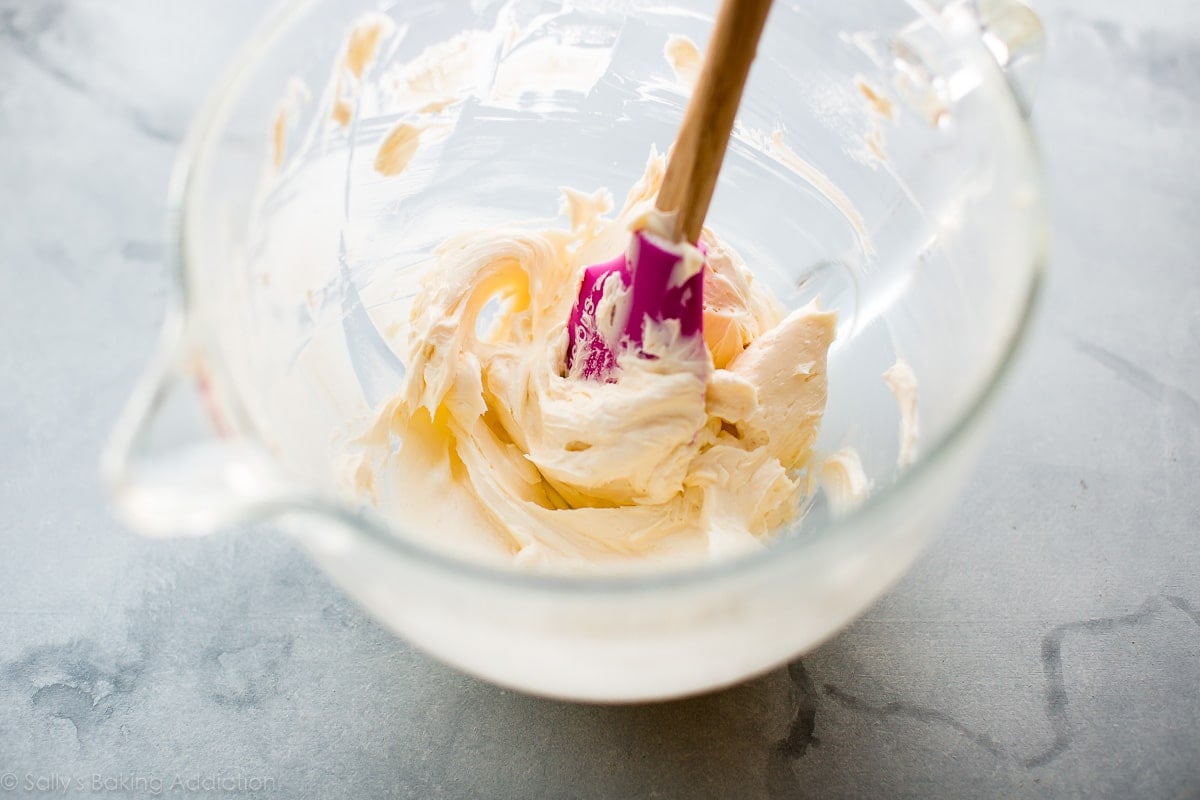
You can use any butter you like best. If you’re going to spend money on European style butter, croissants are when to do it. If I’m being honest, I use store-brand butter and love the croissant’s flavor. It’s butter. It’s going to be good regardless.
The butter rectangle is 7×10 inches, half the length of the dough and the same width, so it fits into the dough. We will chill the butter rectangle right on the silicone baking mat. After it’s chilled, we can peel it right off and place it on the dough to begin lamination.
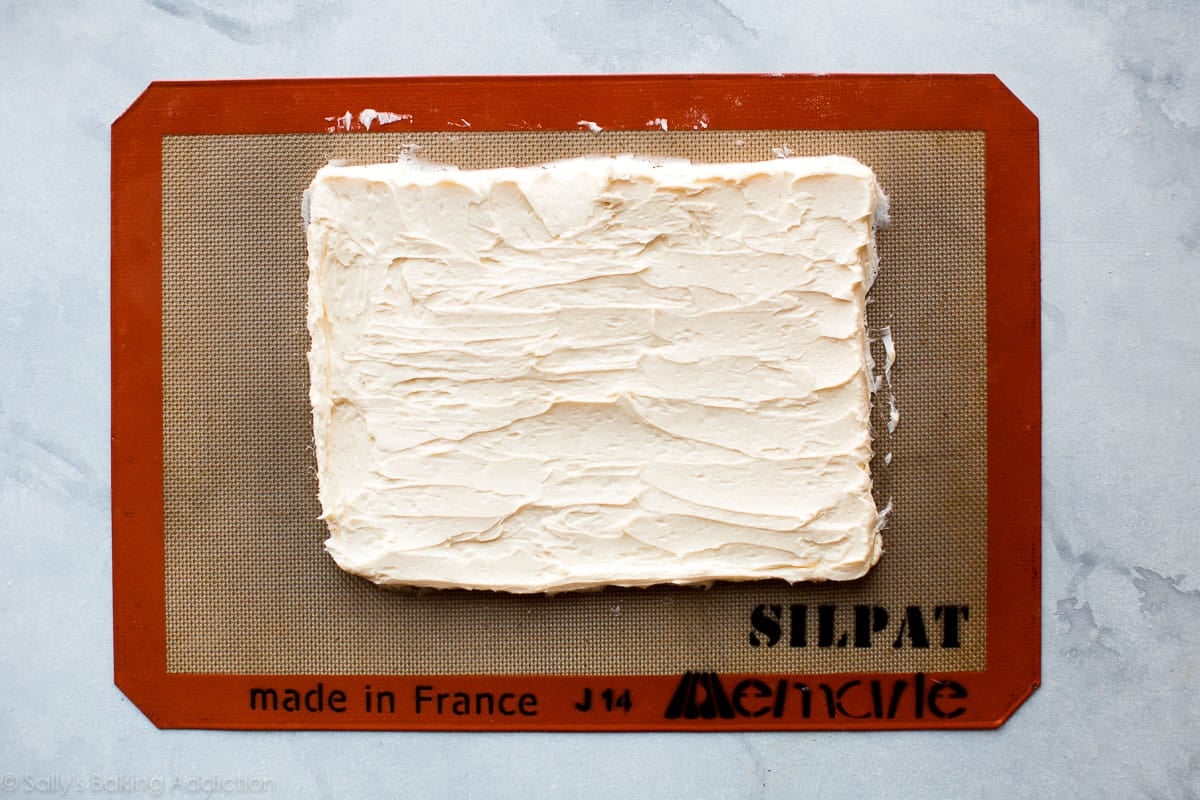
Make sure you only chill the butter for about 30 minutes. Our goal is to have the croissant dough and butter be the same temperature. It makes lamination possible. Butter solidifies much quicker than a soft dough, so that’s why our dough will chill for 4 hours and our butter will only chill for 30 minutes. Make sense?
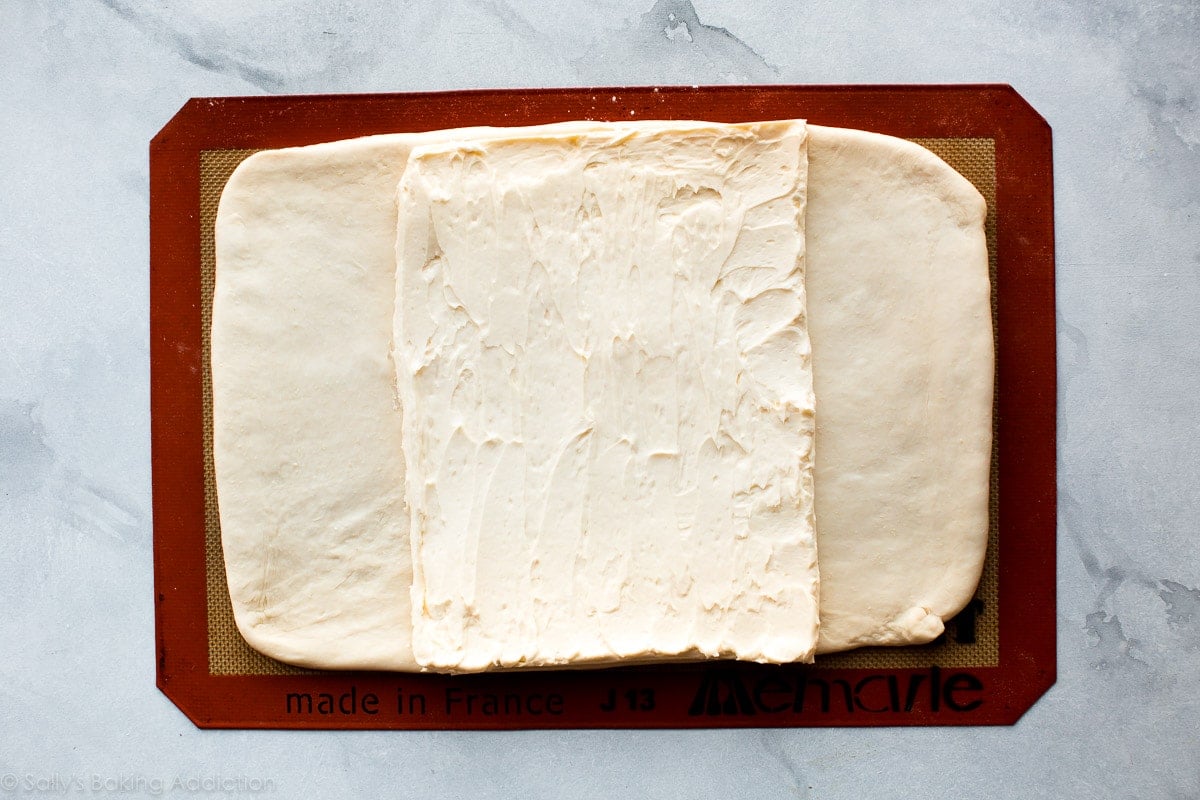
Because you shaped the butter into the precise 7×10-inch size, it fits nicely on the 14×10-inch dough. (After the butter rectangle chills, you can always cut sharp edges with a pizza cutter or knife to make it the appropriate size.)
Fold the cold dough over the cold butter. Use your fingers to seal the butter inside.
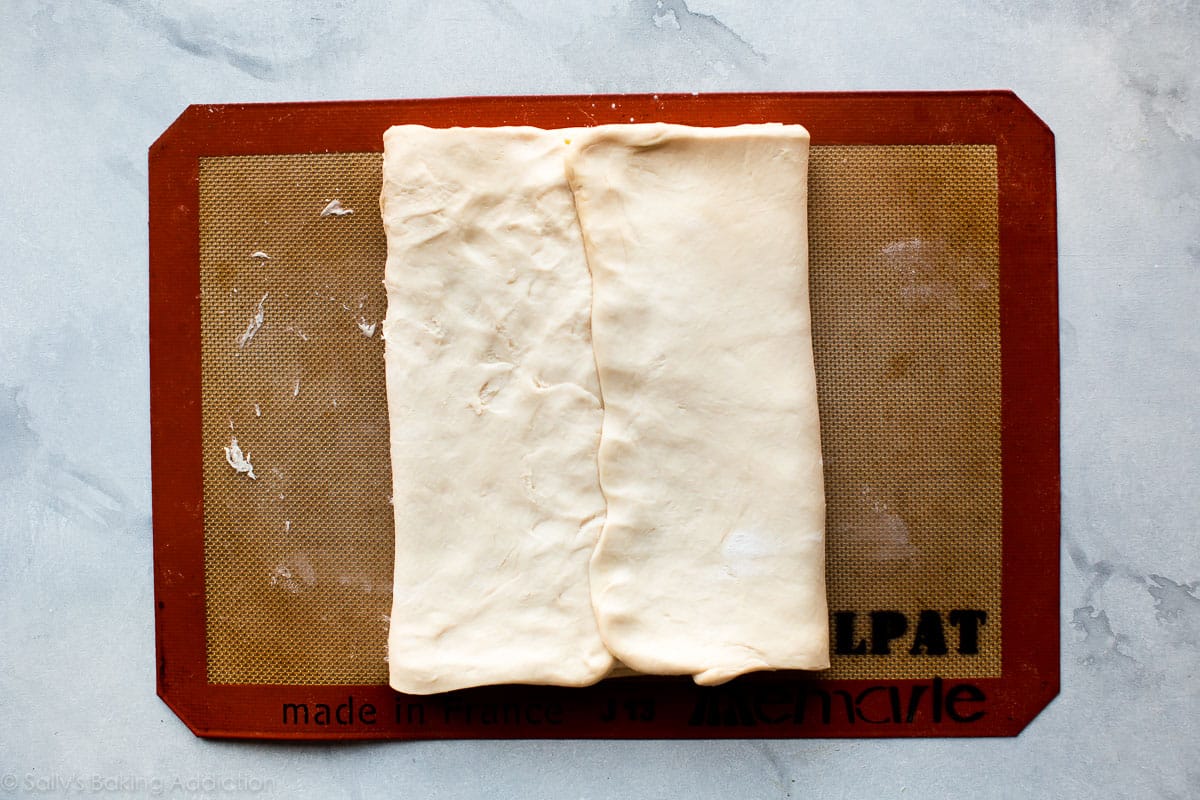
Now we’re going to laminate the dough 3x with a 30 minute break between the 2nd and 3rd time. Why between the 2nd and 3rd time? Because our dough has been out of the refrigerator for long enough by this point and needs to be chilled again. 30 minutes is plenty.
I do not have step-by-step pictures of the lamination process because it’s time sensitive and the dough just became too warm as I tried to set up the shot. However, you can see me laminate the dough and talk through the process in the video below. (3:20-5:15 minutes) Watching me work through this step is more helpful anyway.
Our dough has been rolled out and folded 3x, now it’s time to rest.
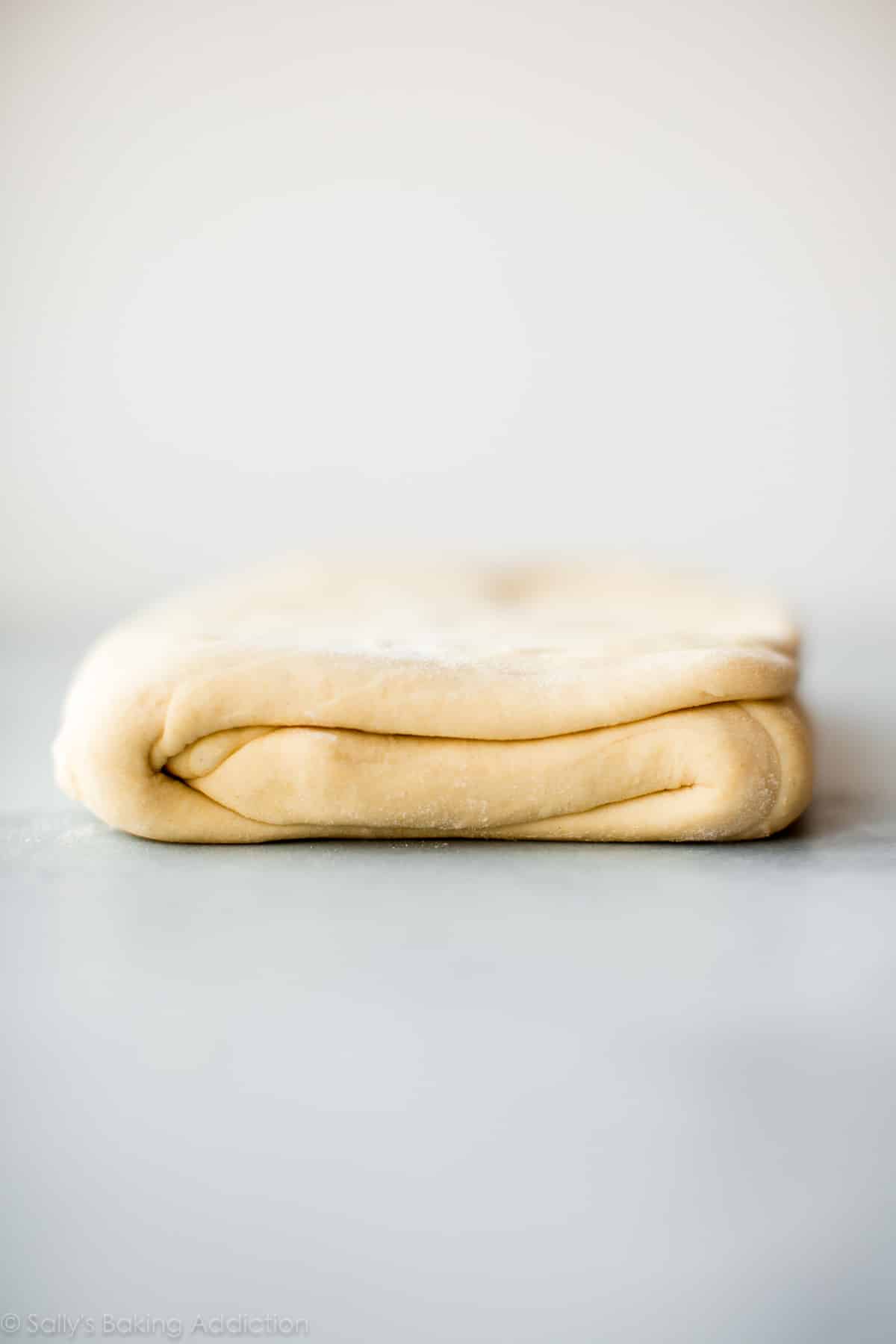
Cover the laminated dough and chill it for 4 hours or overnight. This is when I usually chill it overnight.

Roll out the dough 1 more time. This time you’ll roll it into an 8×20-inch rectangle.
Use your pizza cutter and slice the rectangle down the center to create two 4×20 rectangles. Then slice across 3x to create eight 4×5-inch rectangles.
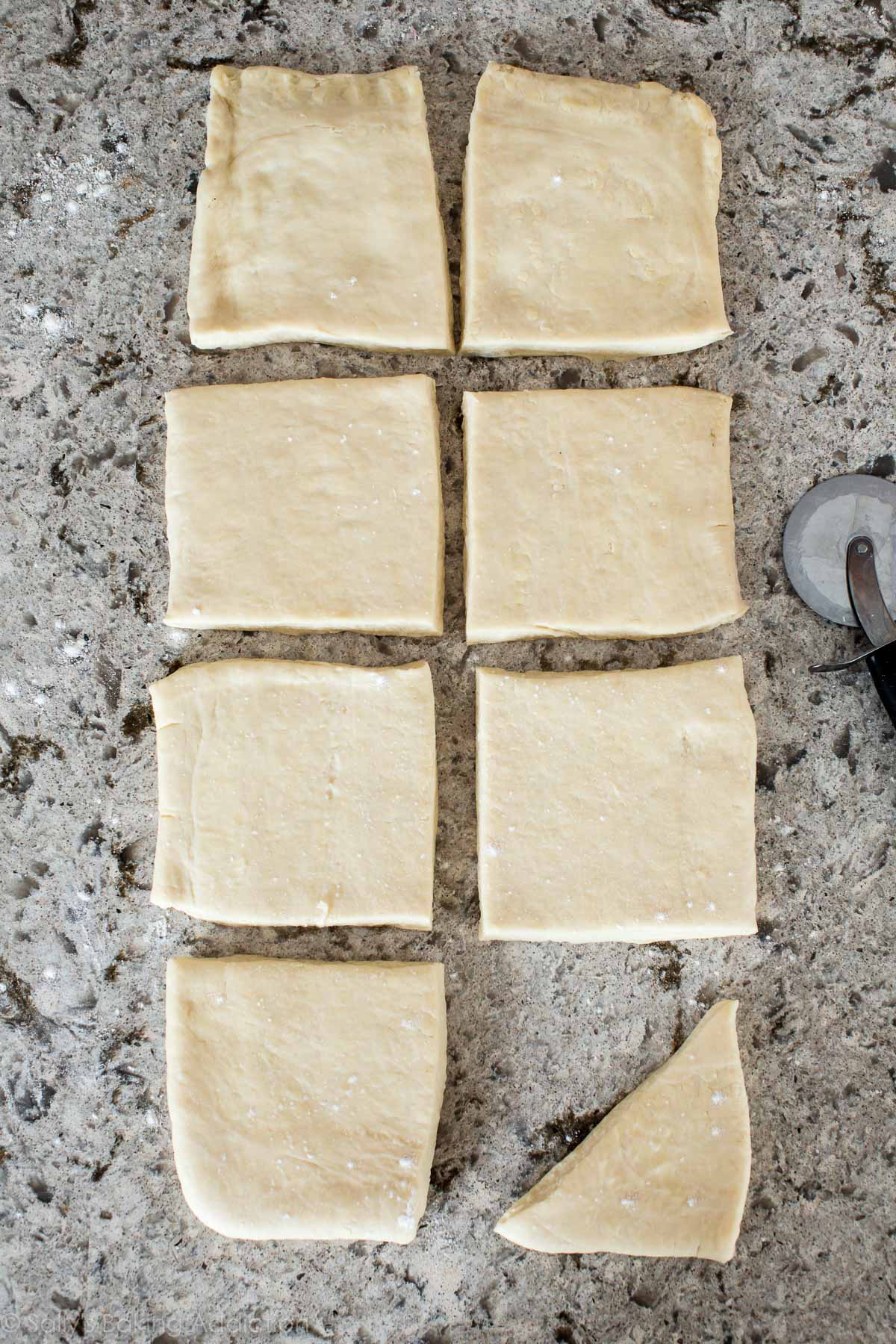
Look at all these layers!!!!
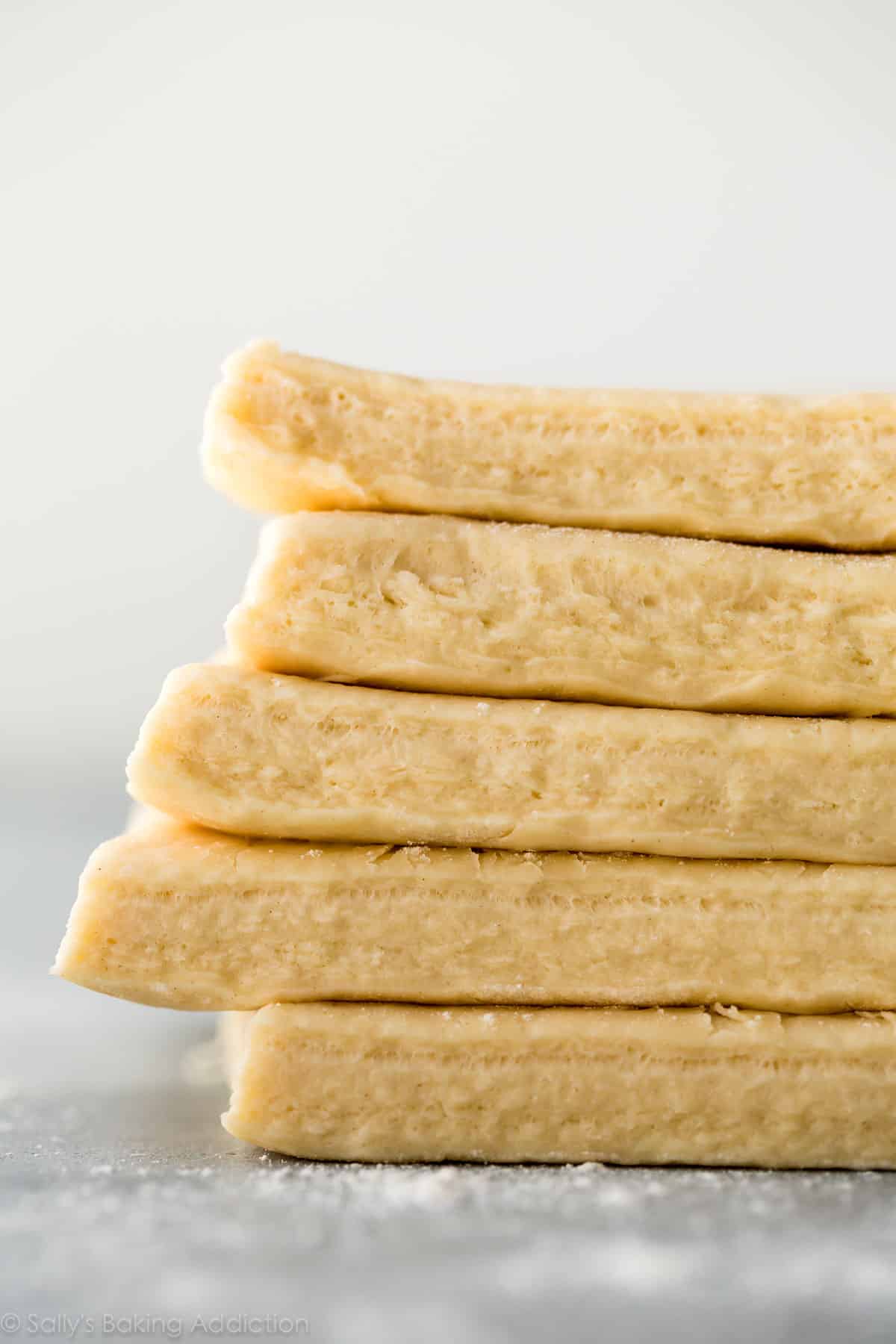
Now slice each of the 8 rectangles into 2 triangles. Using your fingers or a rolling pin, stretch the triangles to be about 8 inches long. Do this gently as you do not want to flatten the layers. Cut a small slit at the wide end of the triangle, then tightly roll up into a crescent shape making sure the tip is underneath.
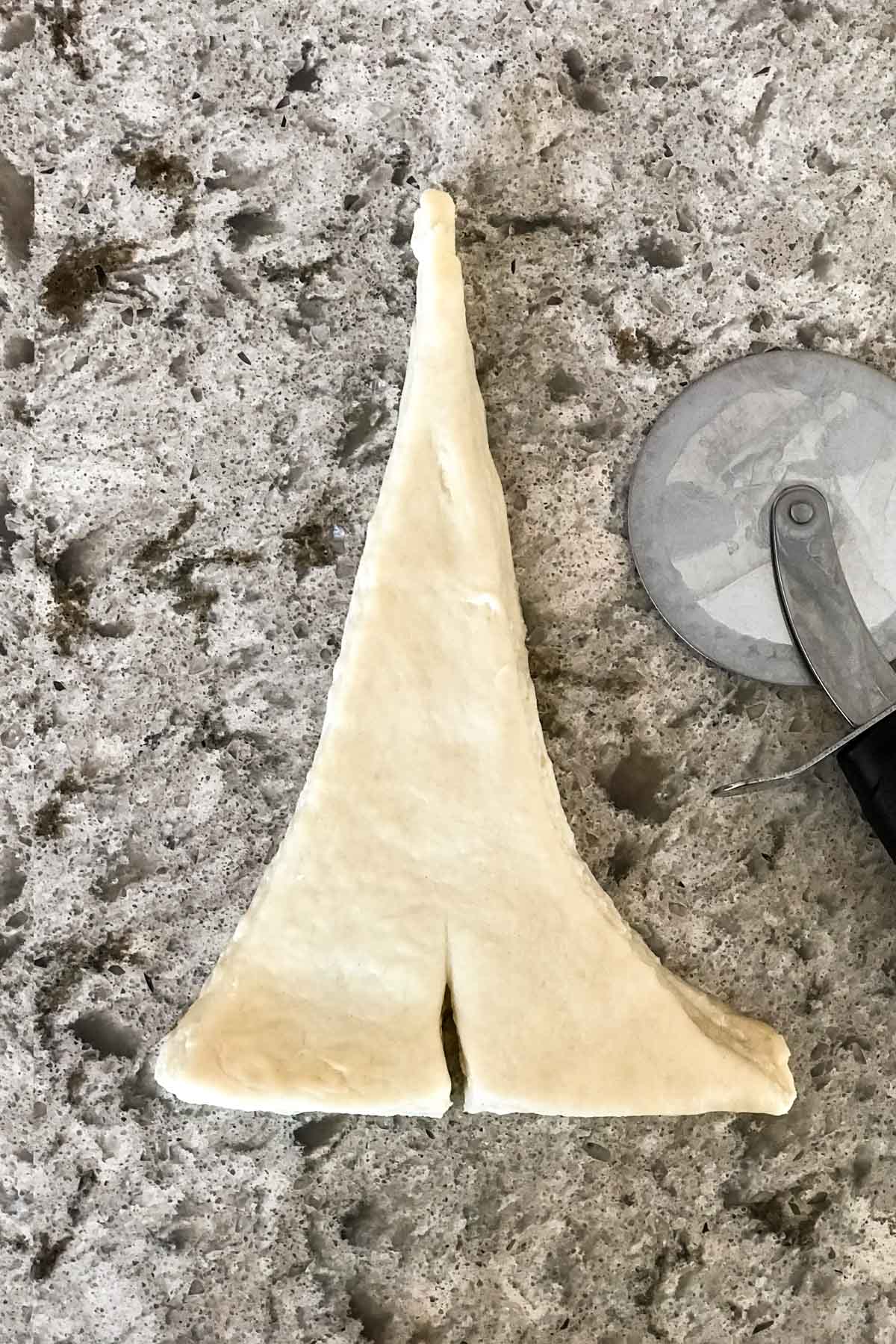
Loosely cover the shaped croissants and allow to rest at room temperature (I suggest just keeping them on the counter) for 1 hour, then place in the refrigerator to rest for 1 hour. Unlike a lot of croissant recipes, I prefer the shaped croissants to be cold going into the oven. They won’t spread as much. They will rise and proof for the 1 hour at room temperature and continue to do so in the refrigerator for another hour.
The croissants are ready to bake after that! FINALLY.
Brush them with egg wash (egg + milk).
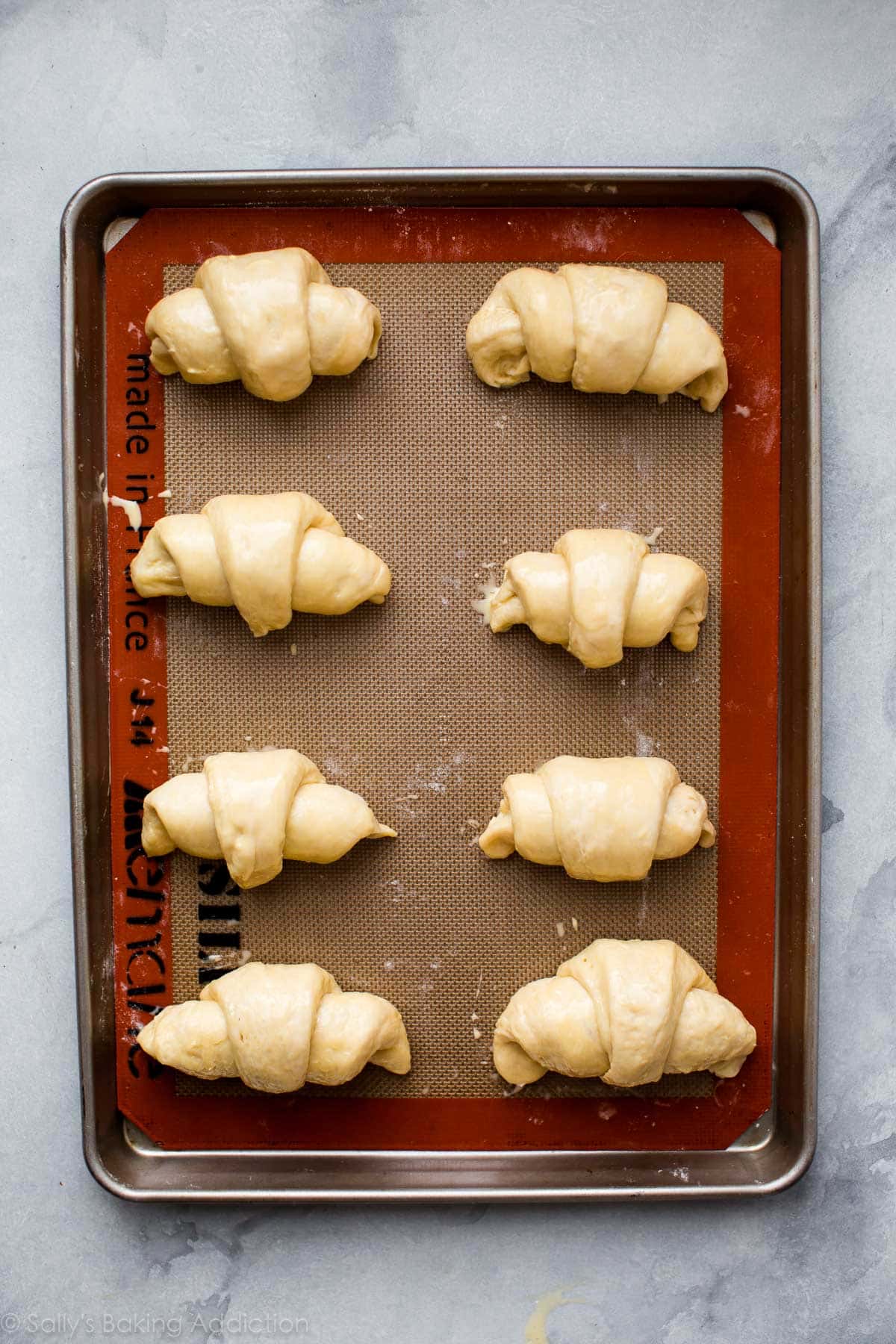
Bake.

Indulge. Because after making the dough and rolling it out a million times, you completely deserve to. Enjoy them plain or with jam or homemade raspberry sauce. Interested in chocolate croissants? Of course you are!
If you happen to have any leftovers, day old croissants are perfect so soak up flavors in an easy breakfast casserole.

FAQ: Why Are There Are Chunks of Butter in my Dough & Why Did Butter Leak Out of the Croissants?
These are 2 common questions and I’m happy to sum it all up for you. Some butter leakage during the baking process is normal and expected, however if your baking croissants are sitting on pools of butter, your butter layer may have been too cold. It would make sense to give the best temperature for the butter layer, but you’re really looking for texture. You want the dough and sheet of butter to be similar in softness. If the butter layer is too hard, it will crack and split under the dough. Let it sit at room temperature to soften before the laminating process (step 7) OR reduce the chill time in step 6 down from 30 minutes to about 15.
See Your Croissants!
Many readers tried this recipe as part of a baking challenge! Feel free to email or share your recipe photos with us on social media. 🙂
Print
How to Make Croissants
- Prep Time: 12 hours, 45 minutes
- Cook Time: 20 minutes
- Total Time: 13 hours, 10 minutes
- Yield: 16 croissants
- Category: Pastries
- Method: Baking
- Cuisine: French
Description
Buttery, flaky, and perfect homemade croissants!
Ingredients
- 1/4 cup (4 Tbsp; 56g) unsalted butter, softened to room temperature
- 4 cups (500g) all-purpose flour (spooned & leveled), plus more for rolling/shaping
- 1/4 cup (50g) granulated sugar
- 2 teaspoons salt
- 1 Tablespoon active dry or instant yeast
- 1 and 1/2 cups (360ml) cold whole milk
Butter Layer
- 1 and 1/2 cups (340g) unsalted butter, softened to room temperature
- 2 Tablespoons (16g) all-purpose flour
Egg Wash
- 1 large egg
- 2 Tablespoons (30ml) whole milk
Instructions
- Preliminary notes: Watch the video below and use the step-by-step photos before you begin. Read the recipe before beginning. Make room in the refrigerator for a baking sheet. In step 6 and again in step 13, you will need room for 2 baking sheets.
- Make the dough: Cut the butter in four 1-Tablespoon pieces and place in the bowl of an electric stand mixer fitted with the dough hook attachment (or you can use a handheld mixer or no mixer, but a stand mixer is ideal). Add the flour, sugar, salt, and yeast. Turn the mixer on low-medium speed to gently combine the ingredients for 1 minute. With the mixer running, slowly pour in the milk. Once all of the milk is added, turn the mixer up to medium speed and begin to knead the dough.
- Knead the dough: Keep the dough in the mixer and beat for an additional 5 full minutes, or knead by hand on a lightly floured surface for 5 full minutes. (If you’re new to bread-baking, my How to Knead Dough video tutorial can help here.) If the dough becomes too sticky during the kneading process, sprinkle 1 teaspoon of flour at a time on the dough or on the work surface/in the bowl to make a soft, slightly tacky dough. Do not add more flour than you need because you do not want a dry dough. After kneading, the dough should still feel a little soft. Poke it with your finger—if it slowly bounces back, your dough is ready to rest. You can also do a “windowpane test” to see if your dough has been kneaded long enough: tear off a small (roughly golfball-size) piece of dough and gently stretch it out until it’s thin enough for light to pass through it. Hold it up to a window or light. Does light pass through the stretched dough without the dough tearing first? If so, your dough has been kneaded long enough and is ready to rest. If not, keep kneading until it passes the windowpane test.
- Remove dough from the bowl and, with floured hands, work it into a ball. Place the dough on a lightly floured silicone baking mat lined, lightly floured parchment paper lined, or lightly floured baking sheet. (I highly recommend a silicone baking mat because you can roll the dough out in the next step directly on top and it won’t slide all over the counter.) Gently flatten the dough out, as I do in the video below, and cover with plastic wrap or aluminum foil. Place the entire baking sheet in the refrigerator and allow the covered dough to rest in the refrigerator for 30 minutes.
- Shape the dough: Remove the dough from the refrigerator. I like to keep the dough on the silicone baking mat when I’m rolling it in this step because the mat is nonstick and it’s a handy guide for the exact measurement. Begin flattening out the dough with your hands. You’re rolling it out into a rectangle in this step, so shaping it with your hands first helps the stretchy dough. Roll it into a 14×10-inch rectangle. The dough isn’t extremely cold after only 30 minutes in the refrigerator, so it will feel more like soft play-doh. Be precise with the measurement. The dough will want to be oval shaped, but keep working the edges with your hands and rolling pin until you have the correct size rectangle.
- Long rest: Place the rolled out dough back onto the baking sheet (this is why I prefer a silicone baking mat or parchment because you can easily transfer the dough). Cover the rolled out dough with plastic wrap or aluminum foil, place the entire baking sheet in the refrigerator and allow the covered dough to rest in the refrigerator for 4 hours or overnight. (Up to 24 hours is ok.)
- Butter layer (begin this 35 minutes before the next step so the butter can chill for 30 minutes): In a large bowl using a hand-held mixer or stand mixer fitted with a paddle or whisk attachment, beat the butter and flour together until smooth and combined. Transfer the mixture to a silicone baking mat lined or parchment paper lined baking sheet. (Silicone baking mat is preferred because you can easily peel the butter off in the next step.) Using a spoon or small spatula, smooth out into a 7×10-inch rectangle. Be as precise as you can with this measurement. Place the entire baking sheet in the refrigerator and chill the butter layer for 30 minutes. (No need to cover it for only 30 minutes.) You want the butter layer firm, but still pliable. If it gets too firm, let it sit out on the counter for a few minutes to gently soften. The more firm the butter layer is the more difficult it will be to laminate the dough in the next step.
- Laminate the dough: In this next step, you will be rolling out the dough into a large rectangle. Do this on a lightly floured counter instead of rolling out on your silicone baking mat. The counter is typically a little cooler (great for keeping the dough cold) and the silicone baking mat is smaller than the measurement you need. Remove both the dough and butter layers from the refrigerator. Place the butter layer in the center of the dough and fold each end of the dough over it. If the butter wasn’t an exact 7×10-inch rectangle, use a pizza cutter or sharp knife to even out the edges. Seal the dough edges over the butter layer as best you can with your fingers. On a lightly floured counter, roll the dough into a 10×20-inch rectangle. It’s best to roll back and forth with the shorter end of the dough facing you, like I do in the video below. Use your fingers if you need to. The dough is very cold, so it will take a lot of arm muscle to roll. Again, the dough will want to be oval shaped, but keep working it with your hands and rolling pin until you have the correct size rectangle. Fold the dough lengthwise into thirds as if you were folding a letter. This was the 1st turn.
- If the dough is now too warm to work with, place folded dough on the baking sheet, cover with plastic wrap or aluminum foil, and refrigerate for 30 minutes before the 2nd turn. I usually don’t have to.
- 2nd turn: Turn the dough so the short end is facing you. Roll the dough out once again into a 10×20-inch rectangle, then fold the dough lengthwise into thirds as if you were folding a letter. The dough must be refrigerated between the 2nd and 3rd turn because it has been worked with a lot by this point. Place the folded dough on the baking sheet, cover with plastic wrap or aluminum foil, and refrigerate for 30 minutes before the 3rd turn.
- 3rd turn: Roll the dough out once again into a 10×20-inch rectangle. Fold the dough lengthwise into thirds as if you were folding a letter.
- Long rest: Place the folded dough on the lined baking sheet, cover with plastic wrap or aluminum foil, and refrigerate for 4 hours or overnight. (Up to 24 hours is ok.)
- At the end of the next step, you’ll need 2 baking sheets lined with silicone baking mats or parchment paper. The dough is currently on a lined baking sheet in the refrigerator, so you already have 1 prepared!
- Shape the croissants: Remove the dough from the refrigerator. On a lightly floured counter, roll the dough out into an 8×20-inch rectangle. Use your fingers if you need to. Once again, the dough is very cold, so it will take a lot of arm muscle to roll. The dough will want to be oval shaped, but keep working it with your hands and rolling pin until you have the correct size rectangle. Using a pizza cutter or sharp knife, slice the dough in half vertically. Each skinny rectangle will be 4-inches wide. Then cut 3 even slices horizontally, yielding 8 4×5-inch rectangles. See photo above for a visual. Cut each rectangle diagonally to make 2 triangles. You have 16 triangles now. Work with one triangle at a time. Using your fingers or a rolling pin, stretch the triangle to be about 8 inches long. Do this gently as you do not want to flatten the layers. Cut a small slit at the wide end of the triangle, then tightly roll up into a crescent shape making sure the tip is underneath. Slightly bend the ends in towards each other. Repeat with remaining dough, placing the shaped croissants on 2 lined baking sheets, 8 per sheet. Loosely cover with plastic wrap or aluminum foil and allow to rest at room temperature (no warmer– I suggest keeping on the counter) for 1 hour, then place in the refrigerator to rest for 1 hour or up to 12 hours. (Or freeze, see freezing instructions.) I prefer the shaped croissants to be cold going into the oven.
- Preheat oven to 400°F (204°C).
- Egg wash: Whisk the egg wash ingredients together. Remove the croissants from the refrigerator. Brush each lightly with egg wash.
- Bake the croissants: Bake until croissants are golden brown, about 20 minutes. Rotate the pans halfway through baking. If croissants show signs of darkening too quickly, reduce the oven to 375°F (190°C).
- Remove croissants from the oven and place on a wire rack to cool for a few minutes before serving. They will slightly deflate as they cool.
- Croissants taste best the same day they’re baked. Cover any leftover croissants and store at room temperature for a few days or in the refrigerator for up to 1 week. You can also freeze for up to 3 months, then thaw on the counter or overnight in the refrigerator. Warm up to your liking.
Notes
- Make Ahead Instructions: Croissants are perfect for getting started ahead of time. The dough can rest for 4 hours or overnight in step 5 and again in step 11. You can also freeze the dough after the 3rd turn in the lamination process (after step 10). Instead of the 4 hour rest in the refrigerator in step 11, wrap the dough tightly in plastic wrap or aluminum foil, place in a freezer zipped-top bag, and freeze for up to 3 months. Thaw in the refrigerator and continue with step 12. You can also freeze the shaped croissants after they rest for 1 hour at room temperature in step 13. (Before placing in the refrigerator.) Cover them tightly and freeze for up to 1 month. Thaw completely in the refrigerator, then bake as directed.
- Special Tools (affiliate links): Electric Stand Mixer | Rolling Pin | Pizza Cutter | Pastry Brush | Silicone Baking Mat | Baking Sheet
- Yeast: I use and recommend Red Star Platinum, an instant yeast. You can use active dry yeast instead if needed. No changes to the recipe or prior proofing required; just mix it in as instructed. (Most modern yeasts are already active!) Reference my Baking with Yeast Guide for answers to common yeast FAQs.
- Keep Dough Cold: Make sure the dough is ALWAYS cold. If it warms up too much, stop what you’re doing and place the dough back in the refrigerator for 20 minutes.
- Floured Surface: Lightly flour the work surface, your hands, the dough, and the rolling pin as you work.
- Air Bubbles: Are there air bubbles in your dough as you roll? That’s ok. Pop them with your fingers or a toothpick, then lightly flour where you popped the air bubble.
- Croissants for Brunch: I recommend starting the recipe the day before in the early afternoon. Complete steps 1-10, then let the laminated dough have a long rest in the refrigerator overnight (step 11). Begin step 13 2-3 hours before brunch.
- Dough adapted from Joy of Baking, Fine Cooking, and Epicurious























Hi Sally, I tried your recipe and ended up with a houseful of smoke from the butter that leaked out of the croissants onto the bottom of the oven! Currently have all doors and windows open with three fans going! It was alarming to see the oven filled with smoKe to say the least. Why do you think I had so much butter leaking out? I’m going to try again.
Hi Brenda, Some butter leakage during the baking process is normal and expected, however if you had that much your butter may have been too cold. It’s hard to give the best temperature because you’re really looking for texture here. You want the dough and sheet of butter to be similar in softness. If the butter layer is too hard, it will crack and split under the dough. Let it sit at room temperature to soften before the laminating process OR reduce the chill time down from 30 minutes to maybe about 15.
I absolutely love all your recipes! I used to have a lot of trouble when it came to baking until I found your page and it has been a game changer. I really enjoyed this croissant recipe it’s great hoping one day you teach us how to make almond croissants they’re my favorite! Thanks for everything 🙂
I’ve been a fan for years, follow your recipes regularly and even own your first book… but I’ve never felt obliged to leave a comment before. Croissants (or quacksons to use his exact phrase) were requested by my 7yo. My husband is not only French, but from Brittany, where buttery baking is almost a religion. So expectations were high! But oh my goodness, this recipe delivered. Easily the best croissant I’ve ever had. Definitely as good as the ones you’ll get in a French boulangerie.
I made half croissants, and half pain Au chocolat, and have a very happy family here this morning. Thanks Sally!!
Hello, a lot of supermarkets have “bake from frozen” croissants in the freezer cabinets, would you be able to freeze these and then bake? I’m assuming if you were to it would be after the egg wash they would be frozen. I’m not sure if the supermarket varieties have any further addatives/changes to the process to make that work. Thanks!
Hi Tom, For the best results, we do recommend thawing the frozen shaped croissants completely in the refrigerator, then bake as directed.
2 Questions:
– would you recommend using fresh yeast? I always use fresh yeast in my baking, but I see you specifically said you recommend dry or instant yeast
– another user mentioned a steam oven. Would you recommend adding a bowl of water to the oven?
I look forward to trying this recipe!
We haven’t tested this recipe with fresh yeast or a steam bath, so are unsure of the results. If you try it, please report back!
Hey, I’m wondering how 4ish days in the post would do to these croissants? I’m hoping to send them to my partner but we’re coast-to-coast, so USPS is a min of 4-5 days in the mail. Since the recipe mentions we can leave them out for a few days, do you have any reccs on what to do once its been received? is it better for me to freeze and then pack them so that they can thaw in transit?
Hi Shri, Can you freeze them and then send them in a freezer pack? They are ok at room temperature for only a few days, so 4-5 days would be pushing it and they may not taste as fresh when they arrive. If they could arrive frozen, you can instruct your partner to thaw them on the counter or overnight in the refrigerator and then warm up to their liking.
Hi!
The croissants tasted great but I had a few issues that I would appreciate advice on.
1) The croissants didnt rise as much as I would want. What could be the reason for this? The yeast is definitely active so that isnt the problem.
2) The layers were not as visible after the lamination as in the pictures. The dough was more dense/homegenous. Could this be due to overworking the dough?
3) I also found that there were lumps of butter that didnt get ironed out in the laminating process. Was the butter maybe too cold?
Any tips would be appreciated!
Is this possible to make without a stand mixer? I have a food processor. Can that work to mix the dough?
Hi Elizabeth, A mixer isn’t necessary. If you don’t have a mixer, you will knead by hand for 5 minutes.
Absolutely the best! Croissants were flaky and delicious. Step by step guide and video were so helpful. First time ever making them and I’m totally sold!
This recipe isn’t really what I’d call a croissant- it tastes more like a pillsbury crescent roll, which isn’t a bad thing if that’s what you’re looking for. For me, it was a bit too rich and very doughy in the middle, not light and airy like a traditional croissant. Maybe that was in the bake for me, but I’ve made croissants a few times using the more traditional method (of hammering a block of cold butter into a rectangle and beginning the turns from there) and they’ve turned out well. Mixing room temp butter with flour and then chilling that was unusual to me.
All this to say, do the croissants taste okay? Yes, because it’s buttery and doughy and a little sweet and nobody has ever said that tastes bad. Was it what I was looking for? Not exactly.
These turned out beautifully! I was worried when I was rolling and folding the dough because the butter was breaking through the dough even though I followed the recipe exactly. The only thing I would do different next time is instead of lightly flouring my workspace, I would put more flour. The butter was breaking through because the dough was sticking to my countertop and breaking. Also, my dough initially was extremely sticky and it seemed like the moisture content was too high. I added more flour until I got to the right consistency. But these turned out better than I could have hoped for!
For those who said that the oven temp was too high… I disagree. I actually turned mine up to 415 for the first 9 minutes and then turned down to 375. I think that also helped with almost no butter leakage and how puffy and flaky these got. My family was upset that I didn’t make more.
These are so great!! I’ve tried a couple other recipes and this one is by far the most detailed and consistent. Definitely recommend keeping the oven a little lower, around 375, for 19-20 minutes to get them flakier. Baked the first batch at 400 for 20 and they came out a little doughier and more bready, but 375 made them perfect!! Love this recipe!
HI, can i leave the dough resting for more than 24 hours??
We recommend sticking with up to 24 hours!
I haven’t tried this recipe yet, but I’m wondering if I melted some chocolate and spread it on the triangles, then rolled them and continued with the recipe if that would work/if anything might go wrong?? Very excited to try this recipe!!
Hi Mac, we actually have a chocolate croissants recipe that we’d follow instead. Let us know how it goes for you!
Making croissants has been on my bucket list. After finding this recipe and the step by step instructions, I took the plunge this weekend. They were delicious! Everyone loved them. I have a few things that I would like to do better next time, but overall they were a success! Thank you so much Sally!
So glad you had success with our croissant recipe, Kelly!
I’ve baked croissants before, but these are the best ones I’ve ever had, and my husband agrees with me. Yummy!!
Thank you so much for this recipe!
I’ve wanted to make croissants for years and finally just did it. They taste great but the bottoms burned so fast!! It could easily be my oven or pans – both prob need upgrading. Will make again for sure
I’ve made croissants before and they’ve been perfect. I was sure it was this recipe but now I’m not so sure. The yeast over proofed and my dough is enormous. I’m popping yeasty bubbles as I roll. I really wish you would list all ingredients in grams. I’m in Australia and I wonder if our measurements are different. It was a cold day and my kitchen is cold the milk and butter and flour for that matter was also cold. I did mix it for longer because it was sticky. Could over mixing be the issue?
Hi Kim, If you find that the dough is overly sticky and is tearing as you work with it, sprinkle more and more flour on it as you shape it and roll it out. Keep the dough as cold as possible, even if that means stopping during any point and refrigerating it for 15-20 minutes before continuing.
LOVE all your recipes!!!Finally getting the courage to make and can’t wait!!!
Quick question – you mentioned a few times in your video that the dough would need to be refrigerated 4 hours – can I refrigerate over night? Thanks.
Hi Mary, yes, up to 24 hours is okay for the long rest. Hope you love the croissants!
This was my first recipe of Sally’s and I’ve since turned to her for about everything else. Super approachable – just take it one step at a time. I use this dough for pain au chocolate and spinach feta pinwheels. I am so grateful to know how to make laminated dough. Mine always splits while I’m rolling- I always get butter leakage. I think I’m too rough with it. In any case, I’ve learned to place parchment paper between my rolling pin and the dough and it helps tremendously. I have much less ripping and spillage.
Hi! i just had the same problem with the dough ripping, does it affect the croissants on a great scale?
Just a suggestion, not just for this recipe, but for all with video instructions: it would be helpful if your written instructions had the time stamp from the video… that way we can “fast forward” to an individual step instead of trying to find where that step is in the video.
Love your site and detailed instructions. Currently making these croissants now 🙂
Sherry, what a wonderful suggestion. I know that would certainly help in this particular video and many others.
I love this recipe so much
Did not enjoy this recipe. It was confusing and unclear. Product did not turn out as expected despite following the recipe exactly.
This is great, amazing instructions that are easy to follow, I’ve made the recipe 4 times with good results. I’ve found shaping to be easier when cutting the equilateral triangles right away, instead of right angle triangles as suggested. All shaping methods have me questioning though, why not roll out the dough to the right length for the triangle? We always then elongate the triangle further. I appreciate your insight on this, and thanks again for the great recipe and instructions!
Hi Vanessa, this is a great question and even though the difference is minimal, I do find working the dough (as a whole) into the correct size to make those 8-inch long triangles to be slightly over-working it. This way, you’re just gently stretching each of the right triangles to be longer. Honestly, it’s easier to work each individual triangle than to continue working the dough as a whole. I hope this makes sense.
This was my first time making croissants and this recipe made it a breeze! They turned out great and I already have plans to make them again.
Deviations:
I used 2% milk with no issues.
I used salted butter but didn’t add salt – do not recommend. Next time I will use unsalted butter + salt.
I left the butter rectangle in the refrigerator for 25 minutes instead of 30. The butter was somewhat cold but still bendy. I had no issues with butter leaking out while rolling or breaking through the dough.
Based on other recommendations, I baked at 375*F for 18 minutes and they were perfect – no major browning on the bottom and moist but cooked on the inside.
These did leak a bit in the oven, but that seems to be normal and I used a rimmed sheet. The croissants seemed to soak up some of the leaked butter once out of the oven (or it evaporated, who knows) and tasted great regardless. Moral of the story: USE A RIMMED BAKING SHEET
First time making croissants so I was a little intimated but excited to try. This recipe was so easy with all the steps and the video. Final product was amazing. My son who is a chef even was impressed.
I loved this recipe a lot. the pastry was great and flaky. I can’t wait to make these again!
the instructions were really detailed, but easy to follow. Loved this, would recommend .
Is a long process for sure. They turned out tasting good but didn’t rise as much as I would like. I will definitely line my pan with parchment paper next time and reduce oven temp to 375 . They were a little too brown on the bottom. Added chocolate to a few- yum.
I usually use the Anna Olsen recipe from Youtube but i decided to try this and it was a major fail. I followed it perfectly and my yeast was very much alive but the dough didn’t rise and I got flat croissants. My hunch is that the cold milk was a bad idea, maybe you should fix the recipe to say lukewarm milk. Anyway I usually love your recipes so i’m pretty disappointed . hope you fix it please.
I have made this 4 or 5 times. This first 2 times they came out absolutely perfect – even my Belgian mother in law declared them “accurate” and had 3! The last few times I have made them, they haven’t turned out and I’m going crazy trying to figure out why they are hard and bread-y and not flakey. Once, it was down to using the wrong attachment on my mixer. I used the regular paddle and not the dough hook and over kneaded the dough.
But the last few times, the croissants are not rising much at all while proofing. My measurements are correct, I check them religiously.
Any ideas what could be going wrong?
Hi Elizabeth, I’m so glad you’re enjoying these croissants. I’m wondering if the issue is with the yeast– is yours expired? Even if the yeast hasn’t reached the expiration date on the package, it could still be dead. Could you try with a new package of yeast? You can always try proofing the yeast in a warm liquid first. To do this, warm 1/4 cup (60ml) of the milk you need for the dough to to about 110°F(43°C). Mix in 1 teaspoon of the sugar needed for the dough as well as the yeast. Cover and let it rest for 5-8 minutes. If the mixture is foamy on top, your yeast is active and ready.
Very nice recipe, works for chocolate or just plain ol croissants. I personally do not care if salted or unsalted butter is used, just grab what is in the refrigerator but certainly use fresh ingredients and good quality yeast. I live up in the Sierra Nevada mountains where the altitude is a bit high and ambient temperatures are a bit low therefore I do not refrigerate the shaped dough for the last hour as mentioned in step 13, in contrast I put the shaped croissants in proofing oven at 80 degrees F for two hours (or when look just right poofy wise) before baking. I also bake at 380 F on a parchment lined air bake baking sheet…just to keep the bottoms nice and golden.
After posting my original comment I circled back around and did a side by side baking of this recipe with salted butter verse non salted butter. I am now firmly in the non salted butter camp. I feel non-salted butter does create a more delicate pastry. A bigger and more dramatic improvement however comes from baking the croissants in a steam oven. All my sourdough and sweet baguettes are baked in a steam/convection oven, steam and then dry heat creates the classic blistered crust of a rustic sourdough bread. Baking this recipe in a steam oven creates a world class result. The finished product is properly layered, has no large pockets of air, has no excess browning on the bottom and has a perfect shiny, slightly blistered crust. In the steam oven I am not using an egg wash.
I have been making croissants for years and finally followed the recipe to a T. I was using salted butter and not I only use unsalted butter – big difference (which I was quite surprised!) I do make these (4 batches) for Easter and make ham and cheese croissants. End up making about 150 – quite a bit of work, but worth it! When doing the final step of cutting I put a small piece of baked ham and a piece of cheese. Roll them up, brush with egg and refrigerate for the needed time. I get rave reviews about them from my family and friends. I even give some of them unbaked with explicit directions and they have hot out of the over ham and cheese croissants for Easter Breakfast along with all the other goodies for Easter breakfast. I also have done the almond croissants. just put a small amount of almond paste mixed with powdered sugar on the rolled out dough follow the rest – put almonds on top after brushing with egg white. Never had another bakery croissant again!